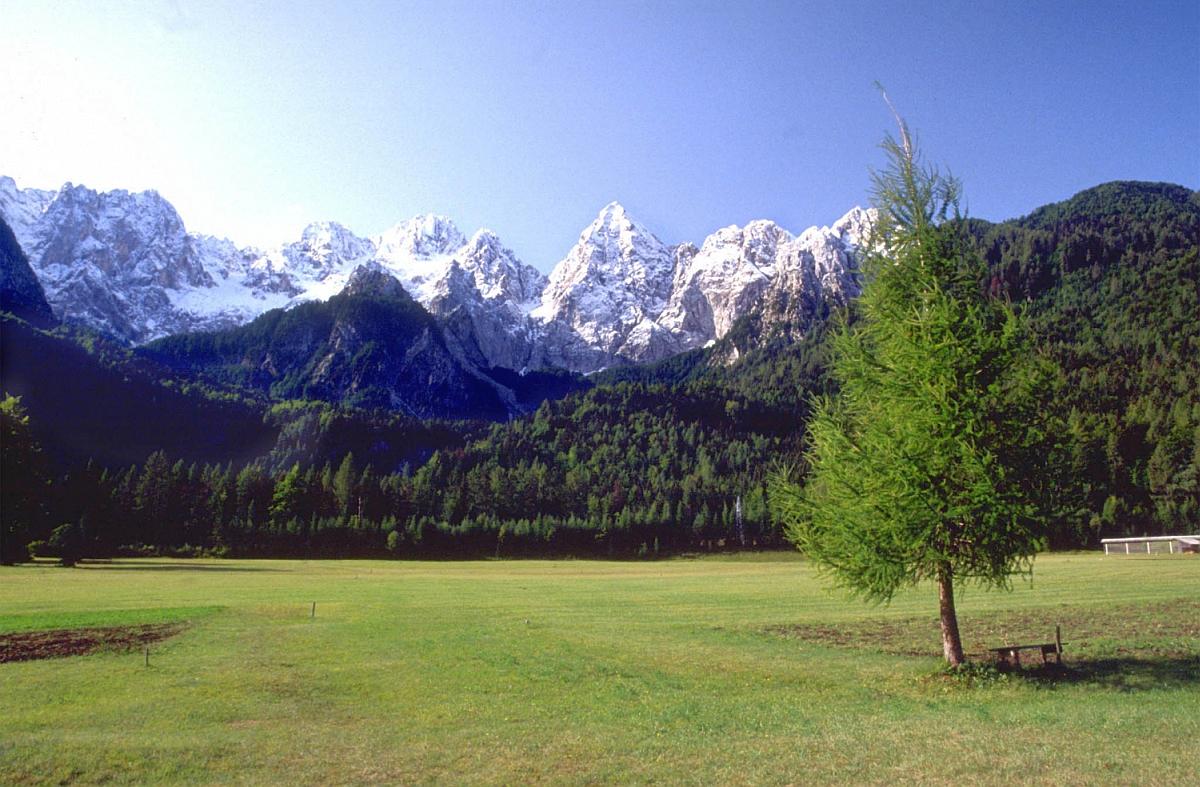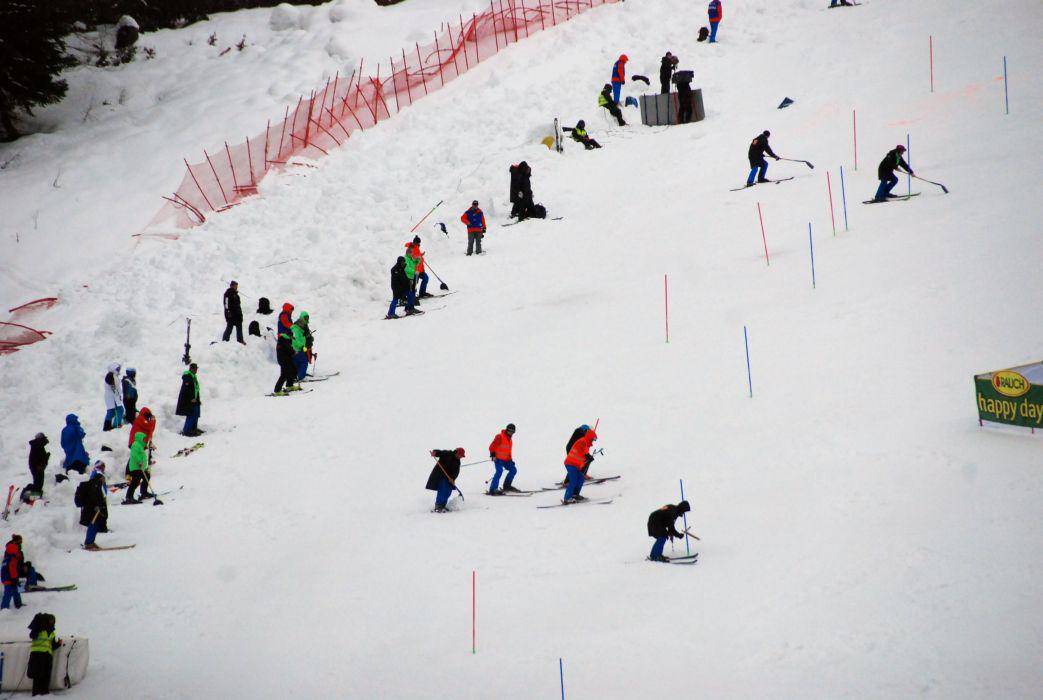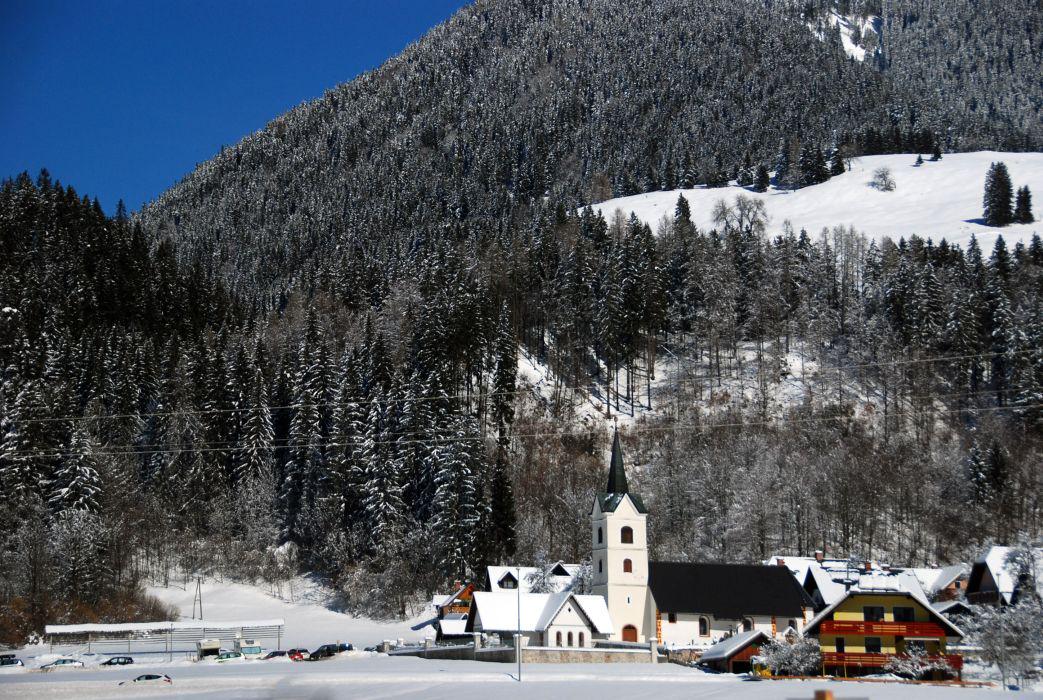





Kranjska Gora – cosmopolitan ski centre
Kranjska Gora is a very active ski centre in the winter, while in summer it is a magnet for cycling events and a great starting point for excursions in nature. It was transformed from being a herding settlement in the 14th century to the present-day cosmopolitan Alpine village due to its increasing strategic importance, which spurred construction of the road over the Vršič pass and the railway line, then later the erection of the Planica Giant ski-jumping slope. The record ski flights this enabled boosted tourism, and the slopes of Vitranc saw the installation of the first cable lift. Today the area also offers a summer toboggan run, climbing wall, fascinating museums, ethnographic events, wild parties and much more.
Podkoren – Alpine heart of the valley
The quiet, removed village of Podkoren is just two kilometres from Kranjska Gora and features all the elements of the Upper Sava architectural heritage. Podkoren, with its ski centre on the outskirts of the village, is the centre for an annual Alpine Skiing World Cup, and also boasts the wonderful Zelenci Nature Reserve, where the source of the River Sava Dolinka is located. Podkoren was the site of a road toll, and through it led a paved medieval road, with mail carriages passing by. Right up until the construction of the Karavanke Tunnel, the road over Korensko Sedlo was the main transport link between Central and Northern Europe, and at that time a lot of mystical stories were gathered there. “My old nest...” wrote the famous British researcher and admirer of Gorenjska, Sir Humphry Davy, about Podkoren and its surroundings. Podkoren can also be a fun place, since it hosts the lively Meeting of Devils from Three Countries, which is one of the most famous Upper Sava public festivities.
Mojstrana – starting point for the Julian Alps and home of Olympians
Mojstrana lies at the entrance to the Triglav National Park, with three magnificent Alpine valleys leading into the heart of the Julian Alps. The Krma Valley offers the easiest access to Mt Triglav, the Kot Valley is a place of enchanting silence, while Vrata will stun you with the Triglav’s mighty north face. Once a place of mining and ironworking, today Mojstrana is most famous for its outstanding alpinists and skiers, for as many as 18 Slovenian Olympians were born in Mojstrana and nearby.
Dovje and Belca – idyllic villages below the Karavanke
Dovje is a village dating back a thousand years, with a farming tradition and the best-preserved typical Alpine architecture. In the settlement of Podkuže at Belca, and not far from Mojstrana, you can still observe cattle grazing freely in the Alpine pastures.
Martuljek Forest and Srednji Vrh – mountain cathedral
Martuljek Forest acquired its name from a stream, while the household names for Srednji Vrh (Middle Peak) are from the period of Turkish incursions. After World War I, this area had developed milling, ironworking, timber floating and charcoal making, which is now being revived as a local tradition. Modern-day Martuljek Forest (Gozd Martuljek) is a wonderful mix of unspoilt Alpine nature, with mountain waterfalls, a rich ethnographic heritage and the Martuljek range with its central slender rocky pyramid of Špik, which gives the rock face a special magic.
Rateče – Planica – the heroes of Planica fly like birds, the best-known tune in Rateče
Slovenia’s icon of folk-pop, Slavko Avsenik, dedicated the song Planica to ski jumpers at one of the biggest ski flying hills in the world, the one at Planica. Rateče is known for its long, cold winters, but also for its abundance of sunny days when you can ramble over Alpine meadows in the foothills of the Karavanke. In the church of St Thomas in Rateče you can see copies of the famous Rateče manuscripts – one of the four oldest written records in the Slovenian language.
Ethnographic gems plus all the adrenaline you want
The winter idyll of the valley offers plenty of active experiences. Skiers and snowboarders will enjoy the challenge of the slopes, and others the chance of recreation on groomed cross-country trails and toboggan runs. And you can engage in some truly special activities climbing frozen waterfalls, skating, ski touring, day and night snow-shoeing, and walking by torchlight. But the soul of Kranjska Gora is and will remain Alpine skiing. A special feature of skiing in this area is the diversity of terrain, which offers high-quality skiing both for beginners and top skiers, as well as ideal spots for snowboarders. Ski cable lifts and pistes are arranged on the slopes of Vitranc from Kranjska Gora to Planica at elevations of 800 m to 1215 m. The ski centres are linked by a system of five chair lifts and 13 drag lifts.
More than 40 km of cross-country trails
Those who love a genuine connection with nature will be thrilled at the more than 40 km of groomed cross-country ski trails, below the downhill ski centres, past the source of the Sava, below the ski jumps at Planica, and on into the Tamar area. The entire Upper Sava Valley is in fact a cross-country paradise. The famous frozen waterfall in Gozd Martuljek, Lucifer, is one of the most popular spots for frozen waterfall climbers. They can test their skills against the frozen waterfalls below Prisank and in Tamar, or against the artificial frozen wall in the Mlačca Gorge in Mojstrana, where Christmas is enlivened by a live Nativity scene with an ice backdrop.
Tobogganing by torchlight
Those who are drawn to revive forgotten moments of childhood fun, or to unwind in a slightly different way, will really enjoy tobogganing. In addition to the toboggan run at the Kranjska Gora ski centre, there is organised night tobogganing on groomed and lit toboggan runs. In the evenings, all-terrain vehicles head out to the groomed toboggan run, to Tromeja, Macesnovec, Gozd Martuljek or Krnica, and all that remains is the “sweetest part” of the adventure: sliding down into the valley by torchlight. But there is plenty more winter fun to be had. Guests can also opt for day or night snow-shoeing, torchlight hikes, bike riding in the snow, skating on little frozen lakes and skating rinks, swimming in covered pools, cavorting in the Kranjska Gora Snow Park or visiting the Kranjska Gora Eskimo Village.
Alongside its sports thrills, Kranjska Gora offers a range of music and entertainment, open-air concerts and in the Vitranc auditorium, plus relaxing in the hotel beauty centres and spas. You can also try your luck at either of the casinos. The high points of the winter season are the world cup events Pokal Vitranc in skiing and Planica in ski flying, along with the major open-air concerts during the two events, Q Max Party and Open-Air Planica.

































































